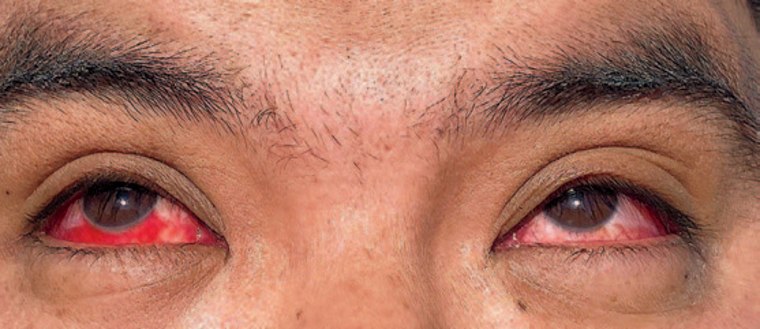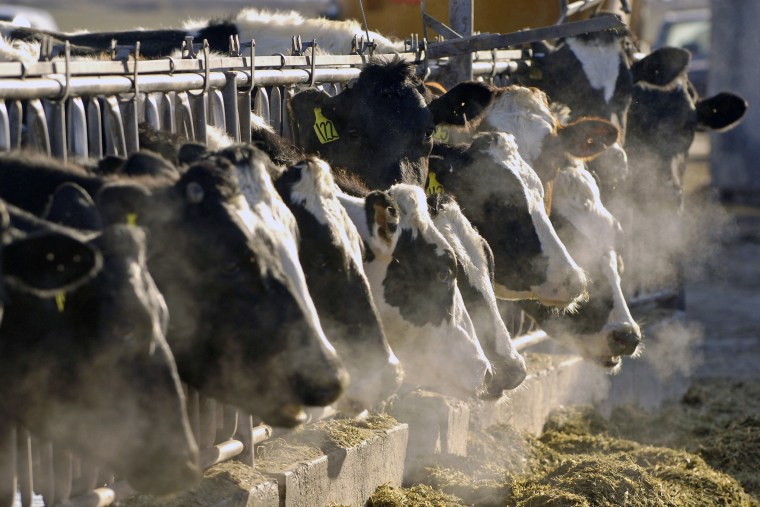The Texas dairy worker who caught bird flu from a sick cow in late March had none of the symptoms typically associated with influenza, including fever, coughing or sneezing. The only indication that he had been infected was a striking case of pinkeye.
Details of the man’s case — the only documented instance of bird flu spreading from a cow to a human — were published Friday in the New England Journal of Medicine, from health officials in Texas and the Centers for Disease Control and Prevention.

Bird flu was first detected in several herds of dairy cows in late March. Around that same time, the man’s right eye started to bother him and became red. He ended up with broken blood vessels in both eyes. Doctors said he had conjunctivitis, or pinkeye. The man had been in direct contact with both healthy and sick cows.
Swabs of the man’s eye and nose revealed he had the same strain of bird flu, H5N1, that was circulating in dairy cows.
The man was given the antiviral Tamiflu and was told to isolate as he recovered. No one he lives with became sick, though they, too, were given the antiviral to reduce that risk, the authors wrote.
He never developed respiratory symptoms, which suggests that the virus may not spread easily from person to person through coughs or sneezes.
Indeed, genetic tests done on samples taken from the man’s eyes and nose confirmed that there were no mutations that would allow the virus to spread this way.
But the threat that mutations like that could arise is real, especially as the virus continues to spread among dairy cows. As of Friday, 36 herds in nine states — Colorado, Idaho, Kansas, Michigan, New Mexico, North Carolina, South Dakota, Ohio and Texas — had been affected by the outbreak.

H5N1 viruses “pose pandemic potential and have caused severe respiratory disease in infected humans worldwide,” the report’s authors wrote. “Therefore, rapid implementation of preventive measures is recommended to reduce human exposures to any infected animals and environments contaminated by them.”
Data from other countries show the virus can have a fatality rate of more than 50% in humans, according to the CDC.
More than 100 people have been told to monitor themselves for symptoms, and about 25 people have been tested for bird flu, the CDC said during a media briefing on Wednesday. So far no one else has tested positive. But veterinary experts suspect that cases are going undetected among dairy farmers worried that they’ll lose their cattle if they report a positive test.
“Farmers are very, very concerned about what happens if they’re positive,” said Dr. Keith Poulsen, director of the Wisconsin Veterinary Diagnostic Laboratory. “When I talk to dairy farmers in Wisconsin, a lot of them just want it to go away like, ‘well, what do we do about it? I’m really only concerned about whether or not I can make my mortgage next week.’”
No bird flu has been found in cows in Wisconsin, but Poulsen said the outbreak has the potential to lower consumer confidence about the safety of dairy products.
“If the dairy industry takes a hit anywhere in the country, then it takes a hit on us, too,” he said. The Department of Agriculture said earlier this week that tests on hundreds of pasteurized products like milk, cottage cheese and sour cream, showed no signs of live virus and are safe to consume.
While the authors of the new report could not rule out the possibility that the Texas dairy worker was infected through respiratory droplets, they wrote that the man likely got infected by rubbing his eyes with a contaminated hand. He was wearing gloves but no goggles or other form of eye protection.
The CDC recommends that anyone in contact with dairy cattle wear protective equipment, including safety glasses, waterproof aprons and boots that can be sanitized.
The authors of the report said they were not able to follow up with the worker to do additional testing to study his antibodies or see how long the virus stayed in his system.






